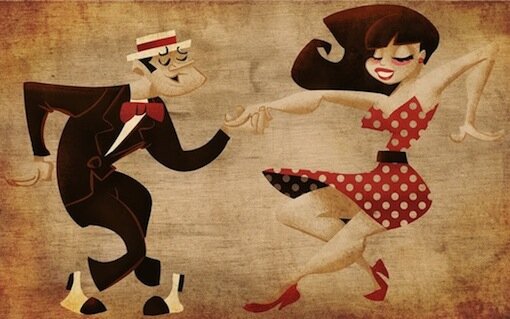The 4 Latin Leads 
9 March 2016
Leading in Latin is a lot less straight forward than in Standard. Whereas in Standard, for the most part, the Man moves and the Lady just sticks to him, in Latin there are four main types of leads the Man may use. Just as it is more complex for the Man to lead, so too is it more complex for the Lady to follow, which is why being aware of what each type of lead is and how it functions is extremely important in both social and competitive Latin dancers.
Weight Change
This is the easiest of the four leads, both for the Man to implement and for the Lady to read clearly. Weight Change leads occur when the Man shifts his weight from one foot to another, and the Lady responds accordingly. Although this lead can be done in any hold, it is most easily felt in Closed Hold. To practice this lead, take Closed Hold with your partner, and have the Lady close her eyes. With a solid (but not stiff) frame, the Man will transfer weight from foot to foot, and the Lady will follow. Next, he may take steps forward, back, or to the side, and finally he may dance Chasses as well. Good leading and following can be accomplished with minimal practice in this way.
This is essentially the same lead that is used in Standard, and in Latin it is used in figures such as the Cha Cha Closed Basic, Samba Reverse Turn, Rumba Cuban Rocks, Paso Doble Chasses, and Jive Fallaway Rock.
Physical
To use a physical lead, the Man will increase pressure through his arms and the Lady will match that pressure, allowing him to control her movement. If the Lady does not match the Man's pressure, the lead works just as well as if the Man did nothing to initiate it in the first place. The physical lead is important in Latin, because, unlike weight change, it allows the Man to affect the Lady's movement without affecting his own. To practice this lead, use Right to Left hand hold, and have the Lady close her eyes. The Lady will continue to travel forward toward her left hand, even if the Man redirects her energy by moving the hand to the left or the right. If the Man increases pressure within the connection and leads her to walk backward, she will continue to walk backward until she feels she is stopped through a stretching of the connection, like a rubber band.
The physical lead is used in figures such as the Cha Cha Open Hip Twist, Stationary Samba Walks, Rumba Three Threes, Paso Doble Separation, and Jive American Spin.
Shaping
The Shaping lead is the least understood of all the leads. To use a shaping lead, the Man will stretch his arms and upper body upward to communicate to the Lady that she should turn under the arm. After the Man has shaped, the Lady must take the initiative to move herself. A common error when using the shaping lead is for the Lady not to respond to it, causing the Man to have to use a physical lead to get through the figure, resulting in uncomfortable partnering and strained dancing. To practice this, the Man will shape his arms and upper body upward, and the Lady will match that shape to turn under arm.
This lead is used in the Cha Cha Underarm Turn, Samba Maypole, Rumba Spiral Actions, Paso Doble Travelling Spins in PP, and Jive Change of Places from Right to Left.
Visual
Least used of all the leads in Syllabus figures is the visual lead, which occurs when the Man and Lady are not touching each other. In this case, the Lady must watch the Man's movements carefully to be able to follow them. Sometimes the Lady must react immediately, which requires an understanding of the figure danced, such as the Cha Cha There and Back. Other times, the Lady may delay her response, such as when the couple is dancing Cha Cha Time Steps and the Man decides to dance a Spot Turn. As a result, the Lady carefully watches the Man as she continues her Time Steps, and then accepts the challenge, dancing her own Spot Turn on the following measure. To practice this lead, the Man and Lady should stand apart, and the Man will move clearly so the Lady can follow him, either slowly and calmly, or with short quick movements to allow the Lady to match him.
In the Syllabus, the only dance other than Cha Cha that makes use of the visual lead is Paso Doble during the Spanish Lines.
How to Use these Leads in your Dancing
Take a look at your routines and determine what lead you are using in each figure. Many figures make use of multiple leads. For example, the Rumba New York starts with a physical lead (steps 1.2) and ends with a weight change (step 3). Determining exactly which lead is being used at each point in your routine will help your dancing flow better, and improve communication between you and your partner.